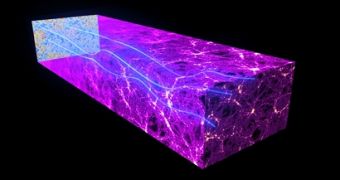For the first time, scientists have been able to take a new look at the earliest light in the universe and use it to get a better picture of the distribution of mass in the universe from the early days to modern times.
Using data from ESA's Herschel space telescope and the South Pole Telescope, scientists were able to verify that gravity has a polarization effect on the cosmic microwave background radiation (CMBR), the first light in the universe that survived to this day, albeit heavily red-shifted all the way to the microwave portion of the light spectrum.
Most light in the universe is not polarized, i.e. photons vibrate along all directions. However, light can become polarized, having all or most photons in a wave oscillate with the same orientation through various phenomena.
One way to polarize light is via gravity. Massive objects, via the phenomenon called gravitational lensing, can add a twist to the light, polarizing it. For the first time, scientists have observed the B-mode component of polarized CMBR light. This, coupled with earlier observations of the E-mode component, can provide clues to the makeup of the universe especially in the early days.
Gravitational lensing can distort the polarized light, mixing the E-mode and B-mode components. This distortion can provide very useful information to scientists.
Even more tantalizing though is the search for B-mode polarization originating in the very first seconds of the universe. It is believed that gravitational waves at that stage imprinted themselves onto the polarization of the light that came hundreds of thousands of years later, when the CMBR was created.
Detecting the B-modes created by the early gravitational waves is a much harder task than detecting the ones generated by gravitational lensing. However, finding them would be a great boon for our understanding of the first stages of the Big Bang, which left very few traces that could be analyzed today.

 14 DAY TRIAL //
14 DAY TRIAL //